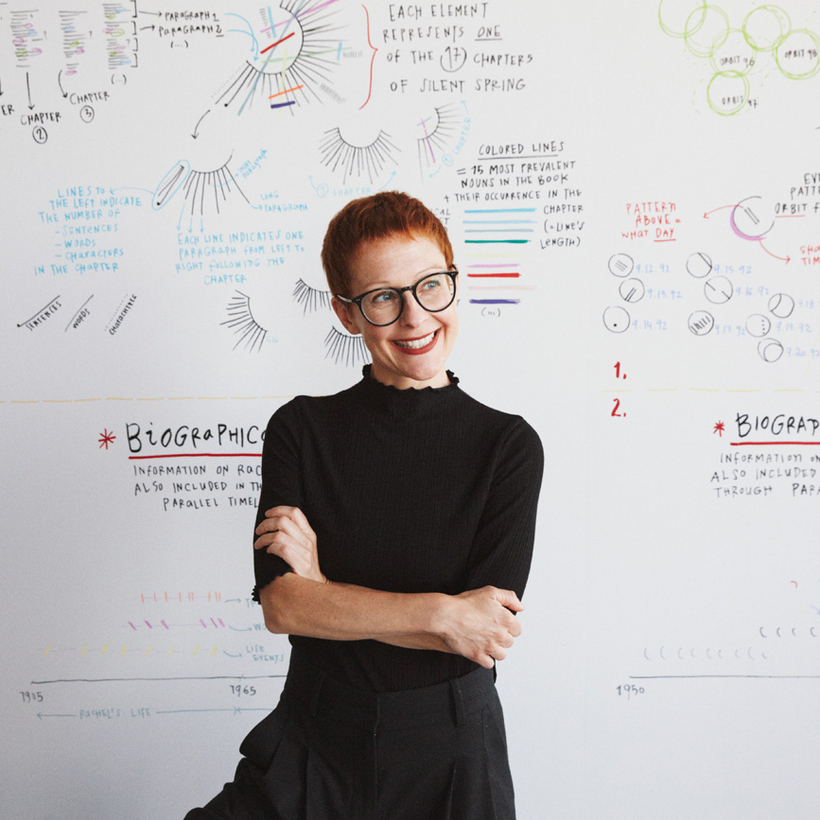The conversation around data—who makes it, who collects it, who owns it—is inescapable, and many consumers would like to reclaim theirs in some meaningful way. And so, & Other Stories, the boutique, artsy offshoot of Swedish fast-fashion behemoth H&M, is turning it into dresses, sweaters, blouses, and even a jacket. For its latest Co-Lab—& Other Stories’ term for its annual collaborative capsule collections—the brand is going meta on the information loop by enlisting the services of information designer Giorgia Lupi.
Drawing Conclusions
Lupi, 38, designs data, and the way she engages with and translates it has made her a star to the cerebral, enlightened set. She grew up in Modena, Italy, earning a master’s degree in architecture before getting her Ph.D. in design at Politecnico di Milano. She has given a Ted Talk, been profiled by The New Yorker, and commissioned by the Museum of Modern Art. Earlier this year, she became a partner at Pentagram, the New York–based design firm. “I’m not an artist; I’m a designer,” says Lupi, who coined the term “data humanism” to explain her work.
Where other information designers deal in cold, hard statistics rendered as pie charts and bar graphs, Lupi reads between the lines to suss out the soft, personal side of a number story. For the 2016 book, Dear Data, co-written with Stefanie Posavec, Lupi counted all of the times she laughed over the course of a week, annotating who and what provoked each occasion. “We can use this invisible layer of information to represent many different areas of our reality,” she says.
Lupi counted all of the times she laughed over the course of a week, annotating who and what provoked each occasion.
Lupi rarely consults spreadsheets or references data that’s already been processed and made available. “I prefer to craft my own,” she says. Then she creates a unique visual language for it, mapping out the data points in graphics that are often hand-drawn. Her style bears the influence of her architecture background, as well as her interest in nature, abstract art, and the Bauhaus. Some of her “charts” look like flowers; others resemble music notes. At a time when data has an insidious reputation, Lupi makes it downright pretty.
That was at least partly the point for Lupi’s range of dresses, tops, and coats for & Other Stories, which launched this week. The collection is broken into three groups, each inspired by a woman who was a pioneer in a male-dominated scientific field—computer programmer Ada Lovelace, environmentalist Rachel Carson, and astronaut Mae Jemison. Lupi mined their stories for unlikely data points, such as the words Carson used most often in her seminal book, Silent Spring, and the color of the sky at certain times during Jemison’s orbit around Earth. Then Lupi translated those facts into prints and embroideries.
Each garment is sold with a bag printed with a legend to decode the pattern. Even so, Lupi is well aware that not every customer is interested in deciphering hidden meaning from her clothes. “I don’t necessarily expect everyone to nerd out understanding how Ada Lovelace posted her algorithm,” says Lupi, whose next big project will concern the 2020 census. As the data always reveals, truly beautiful things tend to sell themselves.
Wearable Data: Giorgia Lupi’s Collection for & Other Stories

Jessica Iredale is a writer and fashion critic based in New York

